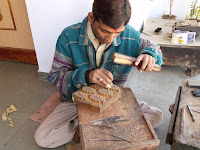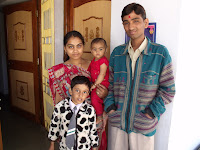
On arrival back to Ahmedabad after my trip to Pethapur about 3pm, I was exhausted and hungry, I hadn't yet eaten that day. The bus dropped me off near Ellis bridge, so I walked over in the direction of the lovely Green house restaurant in the House of MG. I encountered the
SEWA (Self-employed Women's association) on the way though, which I had been meaning to visit, so stopped and had a look. There was another Western girl there, so I asked her if it was open and how to get in. After establishing it was closed for lunch we got chatting, and it turned out we were both from Sheffield. I told her I'd just been to visit Maneklal, and she said she'd also been there the day before. and when she said she was doing her phd in ceramics at Sunderland University, and was on a 6 month research trip in different parts of India, I remembered seeing her visitor's book message, the last one before I wrote my message. She was staying at the '
Arts Reverie' on an artist's residency, a place where I had visited last time and met with Barney Hare-Duke, the co-founder in Manchester. To add to the coincidences, I found out a few days later through an e-mail from her and my mum, that our mums, both nurses had met each other in Sheffield around the same time. How bizarre! There can't be a trip to India without bumping into to someone you know or knows someone you know. Last time it was Georgie whilst at Anokhi, who lives with the best friend of a friend of mine from university.
The afternoon was spent visiting Gamthiwala's the huge block printers and sellers, and shopping in the market.
The problem with trying to do things on your own but whilst staying with a group and wanting to join in on some of their trips, was their constantly changing itinerary. The day after I had visited Pethapur, I had planned to join the group to visit a tie-dye workshop and a remote rabari village. In the morning we got in the car to set off, and I asked what exactly was the plan. 'We're going to visit a block-carver in Pethapur this morning'. You can imagine my frustration. I decided to go anyway as Monit informed me they weren't visiting Maneklal but a different block carver, and I wanted to visit the Rabari village with them after. It took us 45 minutes to get there.
We visited Mukesh and his family. He seems to be the main provider of blocks for Ajrakhpur and Dhamadka. We had tea and were shown the process.
The process - Sagwan wood is used. The older, the better the quality. It is left to dry out for 12 - 15 months . It needs to be completely dry to be able to carve. The block of wood is levelled out with a plain, filed and treated with a to smooth out the surface. It is then coated with a layer of white poster paint so the design is visible when carved. A grid is drawn on the block and is traced through the paper design onto the wood. the amount of blocks for each design depends on the complexity of the design. The main three are the
rekh which is the outline block, the
gudh - background and
dutta, the fillers of motifs. Designs are sent to them in full colour, and the carvers split the design into each of the above accordingly.
That afternoon there was a long drive out to a village called Samou, what seemed like miles out of Ahmedabad. I have since looked for the location on a map, and it is far north of Ahmedabad and north even of Patan, where I remember visiting last time for its beautiful patola weaving (double ikat weaving). If I'd have know I would have asked that we stopped by there on the way!
Samou is mainly occupied by Rabaris - a large community spanning much of Gujarat, Rajasthan, and some areas further south. There are many sub groups each identified by their clothing. But generally they stand out from any other people, the men for their all white outfit of gathered jackets and baggy dhotis, and the ladies for their black shawls covering up bright colours underneath and jewellery all up their ears.
I don't thinks any of them had seen a white person before let alone a big group of girls such as us. The Indian students helped translate but they couldn't always understand the local Gujarati dialect, being quite different from Hindi. So there was a lot of amusement trying to understand each other, and being as in awe of them as they were of us. There were a lot more of them though and we were constantly surrounded by the girls giggling and asking for photos, asking us our name and where we're from.
It was Hayley's birthday and both us and the villagers took great delight in dressing her up in their wedding saris.

After this it was time to bring the cattle in. Me and Tatenda were at the back of the group as everyone walked to where the cattle were coming in. We were rushed onto a bank and didn't realise at the time but the reason was that there were about 50 cows charging round the corner. If we were a few seconds later moving we ma have been trampled! It was quite an exciting sight though. I think the shepherds loved showing off their animals.

We were supposed to go and visit an NGO in a nearby village, but we were so exhausted after all the commotion in Samou, that we decided to head back, especially as it was a long drive and we planned to go out for Hayley's birthday meal.
This we did. Rajwadu, a magical little gem hidden from the business of Ahmedabad's streets. As you enter, you feel like you are going back in time. It feels medieval. There are lots of passageways with candles in the walls, then the next has drapes of colourful fabric making a tunnel, then you arrive in a courtyard holding shrines, floor paintings and a big ceramic font with floating marigolds. After being welcomed we were lead over a little bridge over a sort of moat, down a few more passageways and into another large courtyard where we were entertained while awaiting our meal.

There was music and dancing, including a lady dancing with a huge pile of pots on her head and a man on a pantomime horse. Then they urged us to join in which the Indian students did enthusiastically and us reluctantly, but got into it after a while. The Indian boys loved showing off their moves and there was a big dance off between a few of them and a performer.


After being sufficiently entertained, we were took to our table. The Indian students had bought Hayley 2 birthday cakes and had them suitable iced to the max saying 'Happy birthday Hele'! We sang Happy Birthday, she blew out the candles and cut the cake. We ate the cake before the main meal, as is the custom in Gujarat - They believe its better for the digestion. Something to do with the sugars giving your insides more energy to digest your meal more efficiently.
Then came dish after dish of tasty traditional Gujarati delights. I have no idea what any of these are called. I should know by now, as I recognised a lot of them, having had them many times before, but always forget what they're called. Next time I'll write them down. We got suitable full that I couldn't move afterwards, and remembered I had to go straight to catch a a train! Luckily the food went down quite well so the train journey wasn't too unbearable. Hayley definitely had a memorable day.









































 In the evenings we spent a lot of time at the Law gardens market, shopping for 'Kutchi' textiles. Some seemed genuine, most just cheap rip offs but we all found a good selection of useless things and had a lot of fun haggling!
In the evenings we spent a lot of time at the Law gardens market, shopping for 'Kutchi' textiles. Some seemed genuine, most just cheap rip offs but we all found a good selection of useless things and had a lot of fun haggling!